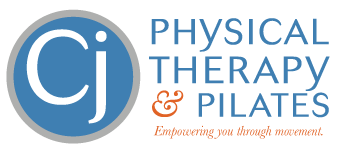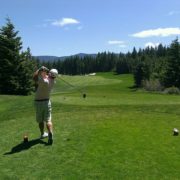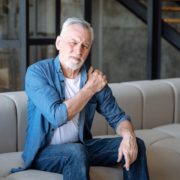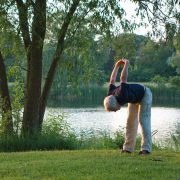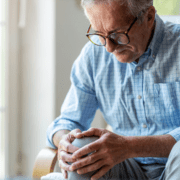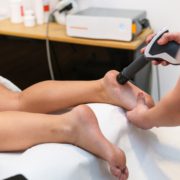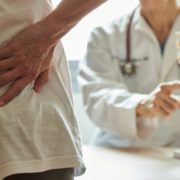For the Dad Who Has Everything… Except Good Knees
It’s that time of year when we celebrate the dads in our lives – and if the one in your life is anything like mine – then he’s probably a little tough to shop for. Maybe he already has all the tech toys and grilling gadgets he wants. Maybe he’s not one to ask for much. But if there’s one thing a lot of dads over 40 don’t have – but wish they did – is good knees.
Knee pain is one of the most common complaints I hear from the men over 40 who walk into my clinic – and it’s also the most common form of osteoarthritis. For some, it’s been a nagging issue for years. For others, it creeps in gradually – starting with a little stiffness when getting up from the couch, or a strange “click” here and there. Then one day, it hits you… Playing golf isn’t fun anymore, and going up and down stairs now feels more like a chore – because your knees just hurt all the time.
Yes, knee pain does become more common as we age – but not necessarily for the reasons you think.
People love to blame arthritis and “wear and tear” for just about everything. And while a previous injury or underlying arthritis might be present, they’re not always the primary culprits. What most people don’t realize – including dads – is that the root cause of knee pain is often mechanical. In other words, it has more to do with how your body moves (or doesn’t move) than what’s actually going on inside the joint.
Let me explain.
Your knees sit between your hips and ankles – two areas that are meant to move a lot and absorb shock. But if the hips or ankles aren’t doing their job properly (which is surprisingly common), that stress has to go somewhere – and the knees usually pay the price. Over time, poor mechanics can lead to pain, inflammation, and breakdown of the joint. But here’s the good news – if the pain is mechanical, it’s very treatable – and sometimes even reversible – all without drugs, injections, or surgery.
So why don’t more dads know about this?
For one, we’ve normalized knee pain – especially in men over 40. There are societal and cultural beliefs like, “You’re getting older, it’s supposed to hurt a little.” Or worse, “If it hurts too much, you can always replace it.” That kind of thinking is unproductive, unnecessary, and can even be dangerous. Yes, knee replacements are sometimes the right call – but far too often, they’re offered before the right conservative options have been fully explored. And with so many cutting-edge, non-invasive technologies now available that promote longevity and let you keep your original parts – dads should absolutely be exploring these options first.
But another big reason? Men – especially dads – tend to avoid asking for help. They’re used to being the fixers, not the ones getting fixed. Many try to “tough it out,” hoping the pain will go away on its own. Others pop ibuprofen or throw on a brace and carry on. But these strategies are just band-aids. They might provide temporary relief, but they don’t address the actual cause of the pain – and in some cases, they can even make things worse.
The real solution starts with a deeper understanding of why your knee pain is happening in the first place. Remember – 80% of all knee pain is mechanical in nature.
So if you or someone you love is dealing knee pain – here are a few important things to keep in mind:
- Rest isn’t always the answer.
It might seem like common sense to rest an aching knee – but too much rest can lead to stiffness, weakness, and poor circulation. In many cases, strategic movement is far more helpful than immobilization. - Pain doesn’t always mean damage.
This is one of the most misunderstood aspects of musculoskeletal pain. Just because something hurts doesn’t mean it’s permanently damaged – and just because an X-ray shows “bone-on-bone” doesn’t mean surgery is inevitable. - The site of the pain isn’t always the source.
Knees often hurt because of a problem elsewhere – such as limited hip mobility, poor ankle mechanics, or even an undiagnosed problem in your spine. That’s why a full-body movement assessment is key to figuring out what’s really going on. - Most knee pain is preventable – and fixable.
With the right combination of movement-based therapy, strength training, hands-on treatment, and regenerative therapy – many people are able to not just reduce their pain – but eliminate it entirely.
So what does all of this have to do with Father’s Day?
If you’re looking to give your dad something meaningful this year, consider giving him a nudge to take care of himself.
Not with another gadget or tie – but with a shift in mindset. One that reminds him that pain isn’t something he just has to live with. One that encourages curiosity about his health, and reinforces that aging doesn’t have to mean giving up the activities he loves.
Because the truth is – most dads don’t want to sit on the sidelines. They want to stay active, strong, and capable. They want to travel, hike, golf, chase their grandkids around the yard, and keep doing the things that make life fun. And they can – if they learn to listen to their bodies and get the right kind of help.
So if the dad in your life has everything… except for good knees… Maybe this is the year to give him something more lasting than another toolset or polo shirt. Maybe this is the year to give him the reminder that his health is worth paying attention to. And that it’s never too late to move better, feel better, and get his knees back.
